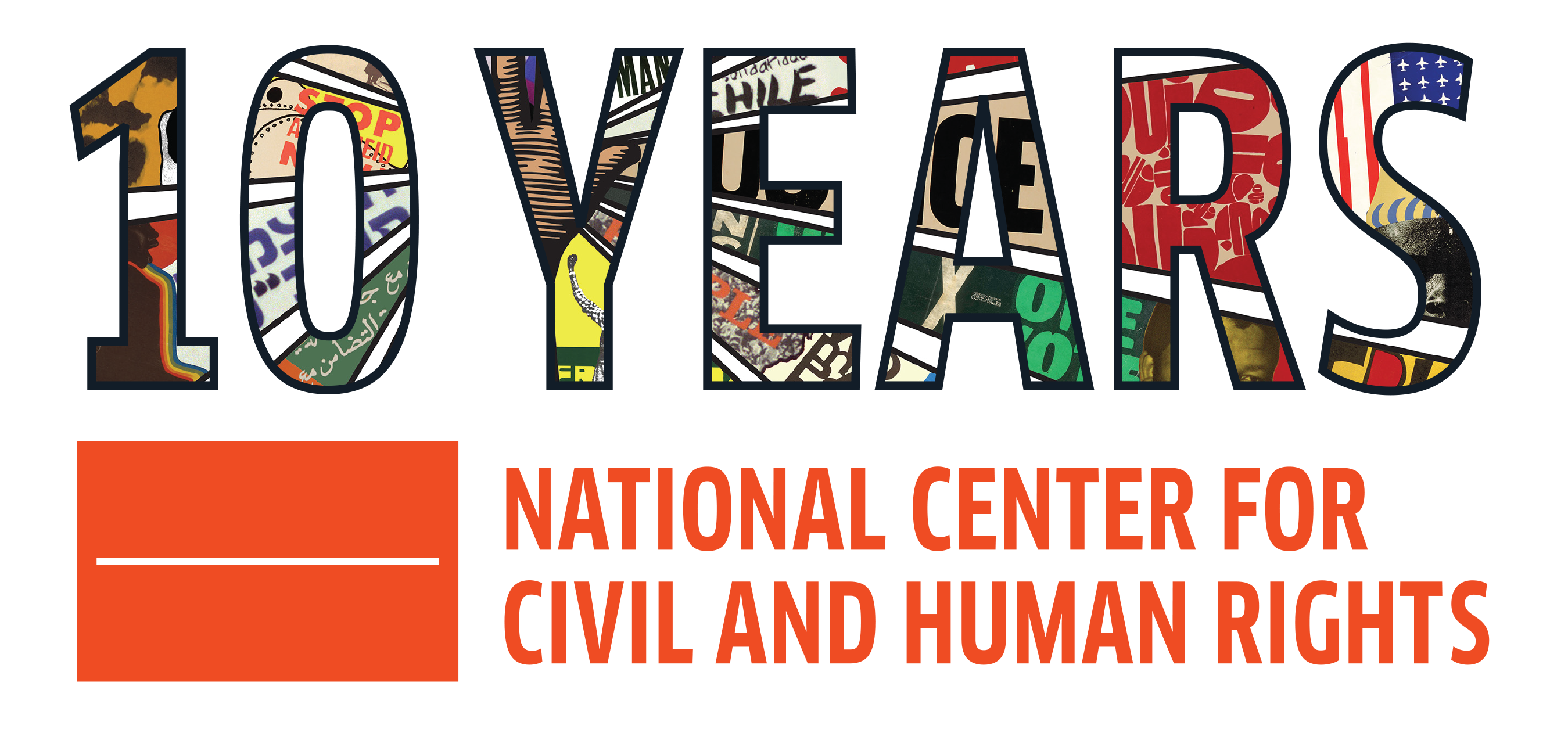Creating The Change They Wish to See: LGBTQ Artists & Their Activism
by Sam Landis
October is LGBTQ+ History Month, the intersection of two things I love – my LGBTQ+ community and history. In the LGBTQ+ community, we do not grow up learning our history in the U.S. Only a handful of states include it in their public school curriculums. This erasure of our existence is linked to the loneliness many LGBTQ+ people feel when coming of age. This is a time when we find we are different from our peers. We would benefit from historical examples to look to, yet school curriculums lack stories that mirror our own experiences. As far as most middle and high school history textbooks go, we do not exist.
Even in the arts, a centuries-long refuge for LGBTQ+ individuals, where I found my profession as a graphic designer. For example, as I write this, I am listening to Tschaikowsky—whom I recently learned struggled with his own male desire. Textbook authors who withheld the story deny us the full picture of his life. To divorce his life and music from his sexuality not only erases part of his identity, but detracts from the meaning you can find in his art. As I listen to Tschaikowsky’s music now, I can feel that internal struggle he must have faced as a Queer person in the 19th century.
We live in a moment when Pride is more mainstream than ever. Fortune 500 companies sponsor pride celebrations. Stores like Target stock up on rainbow merchandise leading into June. LGBTQ+ representation has expanded on TV, particularly in the last two decades, from early shows like The L-Word and Queer as Folk to Pose and Orange is the New Black. More shows center LGBTQ+ characters. Cis-centric shows with LGBTQ+ characters depict their relationships more fully, and ideas like marriage equality are established. During LGBTQ+ History Month, we must remember that a few decades ago, words like “gay” and “homosexual” were used only in hushed tones, if at all. Yet despite the stigma, there were some courageous enough to use their art to share their own queerness and activism with the world. Whether you are an LGBTQ+ person, an ally, or just someone curious to learn more about our beautiful community, my hope is to reveal the resilience of LGBTQ people as seen through the LGBTQ artists I have chosen to highlight.
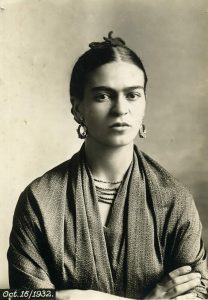
Frida Kahlo
Like many artists, Frida Kahlo was far ahead of her time and was not appreciated in her life like she is revered now. Looking at Khalo’s work I’m captivated by her ability to speak to the intersections of her multitude of identities and experiences. Kahlo was the child of a German immigrant (her father) and indigenous Mexican (her mother). She was disabled for most of her life after an accident as a teenager when a steel bar went through her pelvis. She was a socialist/communist and workers’ rights activist. Khalo was also a women’s rights advocate, and—an LGBTQ icon.
Kahlo had relationships with men and women, many iconic in their own right. They included her husband, muralist Diego Rivera, exiled political theorist Leon Trotsky, painter Georgia O’Keeffe, and photographer Nickolas Muray. She also experimented with her own gender identity and gender expression as documented in photographs and her self-portraits. These self-portraits reveal her interior world. As Frida says, “I am my own muse. I am the subject I know best. The subject I want to better.” Through her brutally honest art, we see themes from her life and issues she championed: her indigenous heritage, her disability, addiction, class and race issues of the time, as well as conflicts of love and identity.
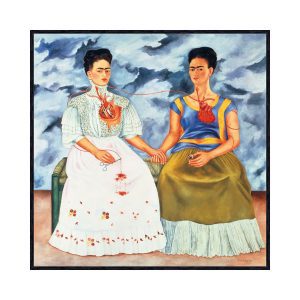
To learn more about Frida Kahlo and see her work visit: artsandculture.google.com/partner/museo-frida-kahlo

Gilbert Baker
In 1978, Gilbert Baker conceived of a new symbol to represent the LGBTQ community, the rainbow flag, first displayed at San Francisco’s 1978 Gay Freedom Day Parade. The rainbow flag is a symbol our community still proudly uses today, with new interpretations being made throughout the years.
“A rainbow flag was a conscious choice, natural and necessary. The rainbow came from the earliest history as a symbol of hope… a rainbow flag would be our modern alternative to the pink triangle.” – Gilbert Baker
Baker’s original flag included eight colored stripes, each with its own symbolic meaning: Pink – Sex, Red – Life, Orange – Healing, Yellow – The Sun, Green – Nature, Turquoise – Art & Magic, Blue – Serenity, and Purple – The Spirit. The pink and turquoise stripes were later dropped due to the cost of dye for those colors, resulting in the better-known six-color design usually seen today. That first year, Baker secured $1,000 to create two flags. The funds were spent on 1,000 yards of muslin, 58 inches wide, 10 pounds of natural dye in eight colors, 100 pounds of salt and ash, and the rest was for art supplies.
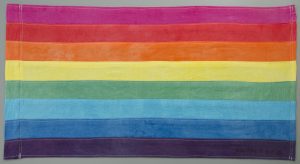
“The real connection to the public happens with confrontation at the boundaries of fear. Art is like a gun that way.”
A lifelong activist, Gilbert Baker participated in protests against the Vietnam War, supported marijuana legalization efforts, and was involved in the gay-rights movement. Baker combined his gifts in the arts with his commitment to justice, using a range of mediums including sewing, painting, design, and performance. This fusion of mediums shine in Baker’s humorously satirical performance art collaborations with the Sisters of Perpetual Indulgence. The Sisters “use humor and wit to expose the forces of bigotry” and have raised millions of dollars for AIDS and LGBTQ+ causes since 1979. Baker continued creating innovative protest art until his death in 2017, but it is the rainbow flag that is his lasting legacy.
“It was his gift to the world, he told me when the flag first went up that he knew at that moment it was his life’s work.” – Cleve Jones (The Founder of The AIDS Quilt) speaking about his friend to the New York Times after his death.
To learn more about Gilbert Baker and his work visit: glbthistory.org/gilbert-baker

Keith Haring
“Art should be something that liberates your soul, provokes the imagination and encourages people to go further.”
Keith Haring was a popular artist in the 1980’s and 90’s whose imaginative visual style captured the interest of a broad audience from art collectors to kids. Haring believed that art should be for everyone, and focused his work in public spaces. He created a visual language of symbols and visual semantics designed to dialogue with his audience. He used this visual language to communicate ideas and start conversations that many people had previously found uncomfortable. Most notably he was outspoken about the AIDS crisis and drug epidemic. Haring used pieces like “Ignorance = Fear” to engage people with abstract ideas that have concrete consequences. Haring died from AIDS complications on February 16th, 1990, but his art lives on and continues to speak to audiences.
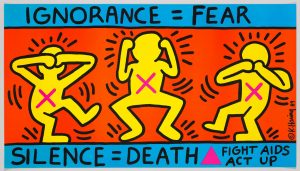
To learn more about Keith Haring and his work visit: haring.com

Jean-Michel Basquiat
Jean-Michel Basquiat was an American artist of Haitian and Puerto Rican descent known for his work in the emerging graffiti scenes of the late 1970’s and 80’s. Basquiat’s work addressed issues that remain sadly relevant today: race, poverty, class, and police brutality. He garnered acclaim at an early age and at 22 was the youngest artist to ever be exhibited at the Whitney Biennial. Embraced by the art world, Basquiat soared to international fame. In 1982 his work was exhibited in New York, Los Angeles, Rome, Rotterdam and Zurich. In 1985 he appeared on the cover of The New York Times Magazine.
Keith Haring, a friend of Basquiat, said of his work: “The stuff I saw on the walls was more poetry than graffiti. They were sort of philosophical poems … On the surface they seemed really simple, but the minute I saw them I knew that they were more than that. From the beginning he was my favorite artist.”
To learn more about Jean-Michel Basquiat and his work visit: basquiat.com
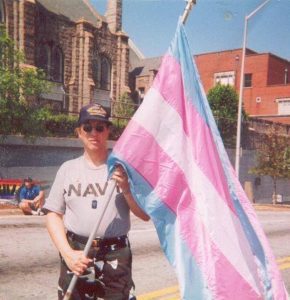
Monica Helms
Monica Helms is a trans military veteran and the creator of the trans pride flag. Originally from Phoenix, Arizona, she now lives in Atlanta, Georgia with her wife. She was inspired to create the trans pride flag after talking to her friend, Mike Page, the creator of the bisexual pride flag.
“One day, I woke up with the idea for the colors—the traditional color, light blue, for boys, pink for girls, and a single white stripe for those who are transitioning, gender-neutral, or intersex. I took it to protests, marches, funerals, transgender days of remembrance. In 2013, I started seeing [my] trans Pride flags flying in other countries. On August 19, 2014, the anniversary of the day I created the flag, the Smithsonian accepted my donation of the original flag.”
You can follow Monica Helms on Twitter at @MF_Helms

Tourmaline
Tourmaline is an organizer, activist, writer, and filmmaker focused especially on trans rights. Some of her films include: Happy Birthday, Marsha! (2018) documenting the lives of trans activists and icons Marsha P Johnson and Sylvia Rivera, The Personal Things (2016) about another trans rights icon, Miss Major, and a film about Eqyptt LeBeija named Atlantic is a Sea of Bones (2017). Her work hangs in the MoMA, Tate Modern, and the Brooklyn Museum. She was named one of Time Magazine’s 100 Most Influential People in 2020. Before she began filmmaking, she was a community organizer for Black, trans, queer, gender nonconforming, and disabled communities.
“Freedom dreams are born when we face harsh conditions not with despair, but with the deep knowledge that these conditions will change— that a world filled with softness and beauty and care is not only possible but inevitable.”
”I’m not satisfied with Black trans lives mattering; I want Black trans lives to be easy, to be pleasurable, and to be filled with lush opportunities. I want the abundance we’ve gifted the world—the art, the care, the knowledge, and the beauty—to be offered back to us tenfold.”
To learn more about Tourmaline and her work visit: queer-art.org/tourmaline
Each of these artists boldly creates from their queerness and impacts the world in their own unique way. They remind us to be true to that which is within us, that we can create beauty from pain, and to not be afraid to make those around us uncomfortable. May we find strength in their stories and inspiration from their art to create the change we wish to see in the world.
____
I would be remiss if I didn’t take this opportunity to share with you a project that is launching this month which I have founded along with some other amazing individuals and organizations – Atlanta LGBTQ+ History Project. The project will gather, share, and preserve the stories and the rich LGBTQ+ history of the Atlanta community. You can learn more about the project by visiting atlantalgbtqhistoryproject.org.
More LGBTQ History Resources
GLBT Archives: glbthistory.org/online-resources
Making Gay History Podcast: makinggayhistory.com
Invisible Histories: invisiblehistory.org
One Archives: onearchives.org
Teaching LGBTQ History: lgbtqhistory.org
Library of Congress LGBTQ+ Resource Guide: guides.loc.gov/lgbtq-studies/
Outwords: theoutwordsarchive.org
About Sam Landis
Samuel Landis is the senior designer at The National Center for Civil and Human Rights where they shepherd The Center’s brand in collaboration with the marketing and exhibition teams, managing all design aesthetics for the institution. Before coming to The Center, they worked in a variety of marketing & design agencies, non-profits, corporate and higher education environments. They moved to Atlanta to attend Savannah College of Art in Design where they received their BFA, graduating Magna Cum Laude. While there, Samuel’s passion for social justice and design was ignited in his role as president of SCAD Atlanta’s LGBTQ student organization. They are currently an LGBTQ Institute Fellow & Co-Founder of the Atlanta LGBTQ History Project. As a designer, artist, and advocate, Samuel is driven by a desire to connect people to stories that matter and create art that shares the beauty of being human.
Connect with Sam:
samlandis.com
Instagram: https://www.instagram.com/iam_samlandis/
LinkedIn: https://www.linkedin.com/in/samuel-landis-609ab8a9/
